Mobile Phase Buffers in LC: Effect of Buffer Preparation Method on Retention Repeatability
LCGC Europe
For liquid chromatography (LC) methods where the buffer pH and composition have an influence on retention, which buffer preparation method will provide the most repeatable results?
For liquid chromatography (LC) methods where the buffer pH and composition have an influence on retention, which buffer preparation method will provide the most repeatable results?
The measurement of pH, one of the most common of all analytical measurements, plays a major role in many chemical processes, affecting everything from the productivity of bioreactors in the biopharmaceutical industry, to the performance of separation methods in liquid chromatography (LC) and electrophoresis. Given that pH measurement is so common, I think we can be lulled into the perception that it is also simple, and that the pH reported by any benchtop pH meter can be accepted at face value under all circumstances. In my interactions working with people at a variety of experience levels over the years, I have often felt that people preparing buffers for use in LC are a little too trusting of the pH values reported by pH meters under ordinary circumstances. In preparation for this month’s “LC Troubleshooting” column, my student Devin Makey and I performed some experiments to see if we could move in the direction of getting answers to questions around the topic of the “best” way to prepare buffers for use in LC. What follows here is a description of those experiments, and the data we observed. I believe that the results are interesting, and can support best practices for improving the reliability of LC methods. I know they are certainly affecting the way we operate in my laboratory, and I hope you will find them useful as well. - Dwight Stoll
Introduction
The Role of Eluent pH in LC: The pH of the eluent has a significant impact on retention and peak shape in several modes of LC separations. This is well understood in reversedâphase separations, where retention is strongly dependent on the solubility of the analyte in the organic-aqueous eluent. The pH of the eluent affects the charge state of various functional groups (COOH, NH2, and so forth), and the charge state of these functional groups has a major impact on the solubility of the analyte in water; this is the origin of the primary influence of pH on retention. For example, a simple weak organic acid like benzoic acid will be neutral (uncharged) in eluents buffered well below the pKa (~4.1), because the carboxylic acid functional group will be protonated. However, in eluents buffered well above the pKa, the carboxylic acid functional group will be deprotonated, and carry a negative charge. The strong interactions between the negatively charged carboxylate group and the highly dipolar water molecules result in a much higher water solubility of the benzoic acid in the high pH eluent, and thus lower reversed-phase retention under these conditions. This is exemplified by the experimental retention data shown in Figure 1 for benzoic acid on a C18 reversedâphase column, where the eluent was buffered at different pH levels.
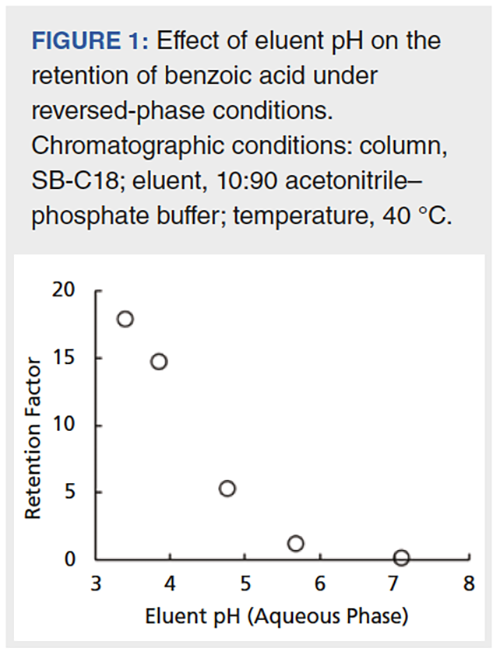
The same chemistry is relevant in hydrophilic interaction (HILIC) separations, though the dependence of retention on pH is often more complicated than it is in reversedâphase separations because of the more influential role of electrostatic interactions between the analyte and the stationary phase in HILIC. The influence of pH on other LC modes, such as ion-exchange, is even more evident because the magnitude of electrostatic interactions between the analyte and stationary phase is the dominant factor influencing retention. Thinking through these examples, it is clear that pH adjustment of buffered eluents is a topic with broad implications in LC.
Current Perspectives on Buffer Preparation: We also recognize that buffer preparation and pH adjustment is a pretty controversial topic in the LC community. This topic has been covered on multiple occasions in this column, focusing on aspects including buffer selection (1), preparation methods (2,3), and the idea of solution pH when an organic solvent is added to the mix (4). In a recent article of our own, we discussed the effects of different methods of buffer preparation on results from HILIC separations (5). In our preparation for this instalment, we have found, through discussions with a variety of people, that they often have strongly held beliefs about what is right and wrong when it comes to buffer preparation, but also that these positions are not always clearly supported by experimental evidence. With this as a backdrop, we set out to make some of our own measurements with the hope that they would add to understanding in this area.
The most commonly used approach to buffer preparation for use in LC involves adding a salt of a buffering agent to water, then adding a small volume of relatively concentrated acid or base solution until a target pH is reached (as indicated by a pH electrode), and finally diluting to a specified volume. For example, suppose we are interested in making 1 L of phosphate buffer at pH 6. Although there are many ways to prepare this buffer, a commonly used approach would be to first add sodium hydrogen phosphate (Na2HPO4) to about 900 mL of water. The pH of this initial solution will be about 9. Then, we could add phosphoric or hydrochloric acid to the solution slowly and watch the pH meter, stopping the addition of acid when the meter reads 6.00. We could then transfer the solution to a 1 L volumetric flask, and fill it to the mark with water. The focus of this article is really trying to answer the question, “If we make this buffer ten times, will we have added exactly the same amount of acid when we have stopped at pH 6.00, according to the pH meter?” If the answer is “yes”, then all is well, and we should expect similar results from LC separations involving these ten buffers. We will show that more often than not the answer is “no”, and that the extent of variation of the acid added from one buffer to the next is enough to cause measurable variability in retention in some cases. At this point you may be asking yourself, “How can the answer possibly be ‘no’?” That in itself is a good question, and one that requires many more words than we can fit in this short article. We’ll come back to this question at the end of our discussion, and suggest some reading material for those interested in really digging into this more. For now, on to the data.
Experiments, Results, and Discussion
Dependence of Retention on pH for Some Probe Molecules: As a first step in this work, we set out to identify some simple probe molecules to use under reversed-phase conditions, and measure the dependence of their retentions on eluent pH. We chose one neutral molecule (ethylbenzene), one weak acid (butylbenzoic acid, pKa ~4.2), and two weak bases (4-hexylaniline, pKa ~4.8; and 4-aminobiphenyl, pKa ~4.3), and used uracil in our test mixture as a column dead time marker. We then prepared about 500 mL each of nine potassium phosphate buffers with expected aqueous pH values between 2.80 and 3.20, in increments of 0.05 units. The approach was to first add potassium phosphate (the same amount in each case, 30 millimoles), then add different amounts of phosphoric acid as needed to reach the target solution pH, and finally add enough water to reach a total mass of 500.0 g. These amounts are shown in Table 1, and were calculated by solving the charge balance equation for this system for the number of moles of phosphoric acid that was required at each pH level. Activity coefficients were calculated using the extended Debye-Hückel equation (6).
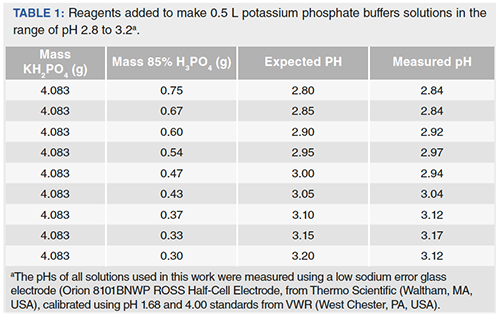
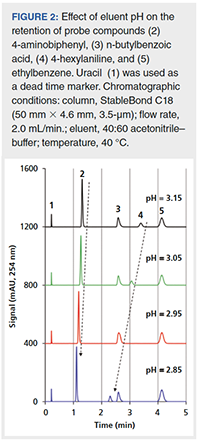
Using each of these buffers as the aqueous component of the eluent, we measured the retention times of the four probe compounds on a C18 column. The resulting chromatograms for five of the buffers are shown in Figure 2, and a plot of the retention factors of the three ionizable probes relative to the retention factor of ethylbenzene is shown in Figure 3. At this point we make two observations. First, Figure 2 shows that the retention of ethylbenzene is nominally independent of pH, as expected, allowing us to normalize the retention of the other three probe compounds to the retention of ethylbenzene to minimize the effects of other variables such as temperature and organic to water ratio in the eluent on these measurements. On the other hand, the retention of the other three probes all exhibit some dependence of retention on pH, with the hexylaniline being the most sensitive of the three by far. Second, Figure 3 shows that the observed retention of each of the three ionizable probes is a smooth function of the calculated pH. Although the exact dependence of retention on pH is unknown for these conditions, we would at least expect it to be a smooth relationship.
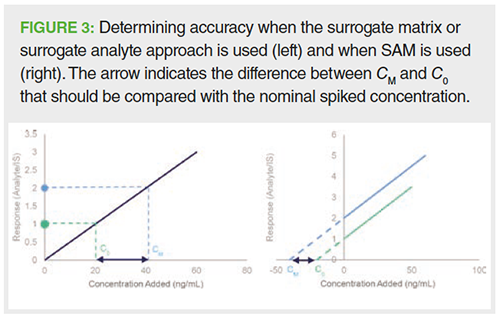
Comparison of pH Meter-Directed and Gravimetric Methods of Buffer Preparation: Now, let’s return to our question above: “If we make this buffer ten times, will we have added exactly the same amount of acid when we have stopped at pH 6.00, according to the pH meter?” We prepared three replicates of a nominal pH 3 buffer as described in Table 1 by using two different methods:
A) pH meter-directed: In this case, we use the pH meter to decide when to stop adding phosphoric acid (for example, when the meter reads 3.00).
B) Gravimetric: In this case, we calculate the amounts of each reagent ahead of time, and repeat that recipe each time, only measuring the pH of the solution when the buffer is complete.
The nominal procedures for the two methods, and the amounts of reagents added for the six buffers used to obtain the data shown in Figure 4, are shown in Table 2.
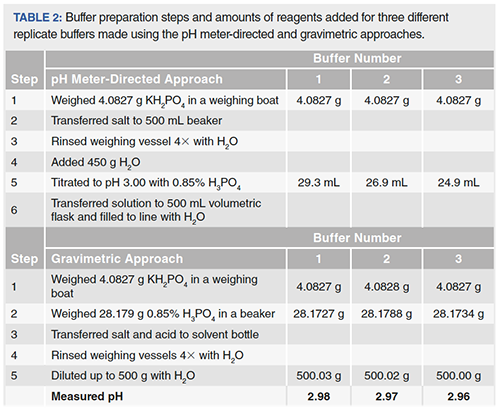
Figure 4 shows the mean relative retention of hexylaniline measured for six different buffers prepared by the same analyst, three by the pH meterâdirected method (all using the same meter and electrode), and three by the gravimetric method. The results are quite clear. They show that the buffers prepared using the gravimetric method lead to much better repeatability of retention time in different buffers, relative to the repeatability observed for different buffers made using the pH meter-directed approach. These results are evidence that the answer to our question posed earlier in this article is “no”. In other words, the pH values reported by the meter are not sufficiently repeatable to guide preparation of the buffer when buffers of highly repeatable composition are needed.
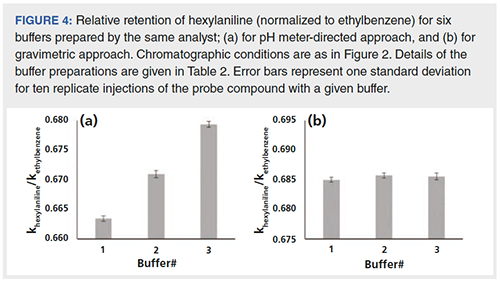
Having settled on the protocol shown in Table 2 for the gravimetric method, three other analysts from our laboratory each prepared three replicate buffers using the pH meter-directed approach, and three using the gravimetric approach. The results are shown in Table 3, where we see that all four analysts were able to produce buffers that led to highly repeatable retention time using the gravimetric approach, whereas the buffers prepared using the pH meter-directed approach always led to much more variable retention times.
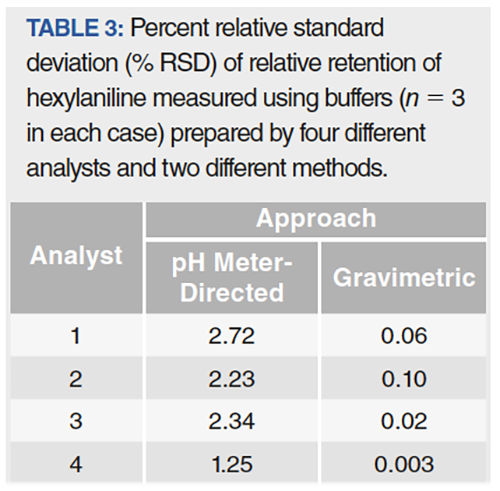
Closing Thoughts
Clearly not all work involving buffered solutions requires the level of repeatability in pH that we explored in this work. However, we believe these results show that, when working with analytes that have a significant retention dependence on pH of the eluent, the gravimetric approach to buffer preparation is worth considering seriously. Simply put, in most cases weighing reagents using a balance is a simpler operation than measuring pH using a glass electrode, and can be done with extraordinary precision compared to most other analytical methods. When the recipe for a particular buffer is known, and repeating the preparation of the buffer in a precise way is desirable, then the gravimetric approach is most precise. Readers interested in learning more about factors that influence the accuracy and precision of pH measurement at this level are referred to Bates’ book on the topic (7). Finally, readers interested in tools for calculation of buffer recipes that can be used with a gravimetric approach are referred to free web-based tools developed by Professor Rob Beynon (https://www.liverpool.ac.uk/pfg/Research/Tools/BuffferCalc/Buffer.html), and Professor Peter Carr and Aosheng Wang (http://zirchrom.com/Buffer.asp) It is important to recognize that the latter tool does not correct pH calculations to account for activity effects, which affect calculated pHs of solutions of high ionic strength and multiply charged buffer components (for example, phosphate at pH 7).
Acknowledgements
We’d like to acknowledge the effort of Hayley Lhotka, Alex Florea, and Gabriel Leme and their willingness to participate in the experiments described here. We also thank Professor Peter Carr and Dr. William Tindall for their willingness to share their knowledge of this subject with us. DM was supported by a grant from the Camille and Henry Dreyfus Foundation.
References
- G.W. Tindall, LCGC North Am.20, 1114–1118 (2002).
- J.W. Dolan, LCGC Europe28(1), 40–44 (2015).
- G.W. Tindall, LCGC North Am.21, 28–32 (2003).
- G.W. Tindall, LCGC North Am.20, 1028–1032 (2002).
- D.R. Stoll and C. Seidl, LCGC Europe31(3), 144–148 (2018).
- L.W. Potts, Quantitative Analysis: Theory and Practice (Harper & Row, New York, New York, USA, 1987).
- R.G. Bates, Determination of pH: theory and Practice (John Wiley and Sons, New York, New York, USA, 2nd ed.,1973).
Dwight R. Stoll is the editor of “LC Troubleshooting” and professor and coâchair at Gustavus Adolphus College.
Devin Makey is an undergraduate student in his fourth year of study in chemistry at Gustavus Adolphus College.
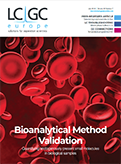
Accelerating Monoclonal Antibody Quality Control: The Role of LC–MS in Upstream Bioprocessing
This study highlights the promising potential of LC–MS as a powerful tool for mAb quality control within the context of upstream processing.
Using GC-MS to Measure Improvement Efforts to TNT-Contaminated Soil
April 29th 2025Researchers developing a plant microbial consortium that can repair in-situ high concentration TNT (1434 mg/kg) contaminated soil, as well as overcome the limitations of previous studies that only focused on simulated pollution, used untargeted metabolone gas chromatography-mass spectrometry (GC-MS) to measure their success.
Prioritizing Non-Target Screening in LC–HRMS Environmental Sample Analysis
April 28th 2025When analyzing samples using liquid chromatography–high-resolution mass spectrometry, there are various ways the processes can be improved. Researchers created new methods for prioritizing these strategies.
Potential Obstacles in Chromatographic Analyses Distinguishing Marijuana from Hemp
April 28th 2025LCGC International's April series for National Cannabis Awareness Month concludes with a discussion with Walter B. Wilson from the National Institute of Standard and Technology’s (NIST’s) Chemical Sciences Division regarding recent research his team conducted investigating chromatographic interferences that can potentially inflate the levels of Δ9-THC in Cannabis sativa plant samples, and possible solutions to avoid this problem.

.png&w=3840&q=75)

.png&w=3840&q=75)



.png&w=3840&q=75)



.png&w=3840&q=75)










